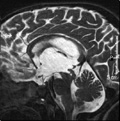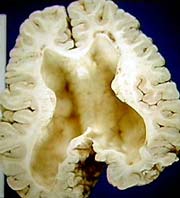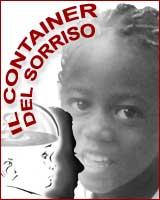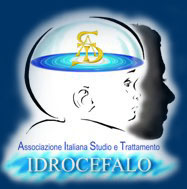Hydrocephalus is a pathology often found in both children and adults. .
It is characterized by an accumulation of cerebrospinal fluid in the cerebral ventricles, and can be consequent to a congenital malformation or acquired through tumours, infections (meningitis, ventriculitis), or hemorrhages, where it often presents the worst complications. Recent evolutions in hydrocephalic treatment consider this pathology to be one of the most controversial areas in terms of the surgical/medical establishment. Until some years ago patients were treated exclusively with a system consisting of a silicone tube that allowed for the release of the accumulated liquid from the the ventricular system into the cardiac atrium or the peritoneal atrium with the flow regulated by a mechanical valve. This treatment does not lead to recovery but temporarily resolves the problem, as the effects of the treatment last medially on average for ten to twelve years, with patients that are operated on more than once a year (due to the appearance of frequent and terrible infection, hydrodynamic, and mechanical complications). In children, furthermore, due to the high rate of natural growth, it is necessary to operate before a serious malfunction to the system becomes apparent. Research in this field has resulted in the realization of very sophisticated valves, catheters filled with antibiotics, and elaborate surgical protocols that all act to reduce the unnacceptably high frequency of re-operations in these patients
 Apart from the shunt/catheter-based system, hydrocephalic surgery has for some years now availed itself of the technique of endoscopy, which has aroused much enthusiasm from experts, as it allows for the complete recovery of many patients that otherwise, if treated with the classic ventricle-peritoneal or ventricle-atrial system, would be condemned to a life of surgery with the constant risk of suddenly finding wounds from serious infections or from valvular malfunctions.
Apart from the shunt/catheter-based system, hydrocephalic surgery has for some years now availed itself of the technique of endoscopy, which has aroused much enthusiasm from experts, as it allows for the complete recovery of many patients that otherwise, if treated with the classic ventricle-peritoneal or ventricle-atrial system, would be condemned to a life of surgery with the constant risk of suddenly finding wounds from serious infections or from valvular malfunctions.
The endoscopic treatment consists of making a small hole in the lining of the third ventricle, bypassing the obstruction (congenital or acquired: the actual cause of the hydrocephalus) and permitting a physiological flow and reabsorption of the liquor. Furthermore, with this technique it is often possibile to directly treat the cause of the hydrocephalus, resolving the sickness with which the “hydrocephalus complication” is associated. Dr. Pieri, thanks to his scientific interest and to having traversed a long and difficult journey of study and research conducted at the side of illustrious neurosurgeons, has acquired a most notable experience in regards to this new technique, and currently has treated more than 100 cases successfully, without operative or postoperative complications. The general incidence of the surgical complications is less than 1%.
This treatment presents its greatest success in the congenital or acquired stenosis in the Acqueduct of Silvio, with around a ninety-five percent complete and definite recovery rate, and with a high percentage of success for all the other forms of hydrocephalus, so high that the treatment is now widely considered to be the first choice. We use the shunt-based treatment for those who, unfortunately, do not have the necessary indications, in their specific cases, for the endoscopic treament, or who do not respond to the endoscopic treatment.
Our approach to hydrocephalic patients is first and foremost to assess the possibility of a decisive endoscopic treatment (total recovery!) and, in the case where such a treatment is not possible, to use a silicone shunt suitable to the specific clinical case. There are hundreds of diverse shunts on the market that range from less-sophisticated models to those more recent and specially made, in particular those that drain the liquid directly from the cerebral transverse venosus sinus (Sinu-Shunt): for this new treatment we have the best case record in the world.

Dr. Pieri, after having trained in and studied about, professionally and technically, this new surgical technique at the Neurosurgery University of Copenhagen, was the first in Italy to implant this new shunt and now has a record of more than forty cases, ten of which utilized local anasthesia. At the beginning of this study, in September 2001, Dr. Pieri organized a congress in Italy where Dr. Børgesen, inventor of the Sinu-Shunt, participated and presented the innovative characteristics of his shunt to the national neurosurgery community. Following the presentation, on live video and accompanied by Dr. Pieri, Dr. Børgesen operated on a hydrocephalic patient with his new shunt, the first time this had been seen in Italy.
Dr. Pieri is moreover the first neurosurgeon in the world to have implanted the Sinu-Shunt in a pediatric patient, resolving a disperate situation which was affected by an infection to the previous shunt-system after twenty operations in seventeen months.
The Sinu-Shunt consists of a silicon tube with two one-way valves at zero pressure; this tube in turn hides a smaller titanium tube that regulates the flow of liquid at a “natural” rate. This shunt establishes communication between the ventricular system and the cerebral transverse venosus sinus that represent, together with the contralateral transverse sinus and the superior longitudinal sinus (which communicate together), the physiological site where the liquid is normally re-absorbed (in healthy people the rate of absorption can be higher than 0.5 liters a day!). The quantity of liquid drained is regulated solely by the internal pressure of the sinus venosus, which permits the liquid to drain at a natural physiological rate.
This new system presents clear advantages:
1. it is shorter than other shunts, so it has less of an exposed prosthetic surface at risk of infection (2% as opposed to 8-14% in the old systems);
2. in all of medical literature there has never been a verified complication in regards to thrombosis of the sinus cavity;
3. the valvular system is very simple, drastically reducing the risk of the valvular obstructions or dysfunctions found in the traditional complicated systems;
4. it does not provoke the terrible “hyperdrainage syndrome,” frequently caused, in the other valves, by negative atrial or abdominal pressure;
5. being positioned only at the head-level, all the mechanical complications due to straining, spraining, kneeling or disconnection, all characteristic of the old valves that had to go through a flexible structure like the neck (to meet the heart or abdomen), are done away with, as are all the abdominal complications (peritonitis, encystments, intestinal perforations, adhesions, etc…);
6. it is the only valve that can be implanted with local anaesthesia in complicated patiens in which is contraindicated the general anaesthesia; hydrocephalus being a pathology whose treatment with ventriculo-peritoneal or atrial shunts until now has always needed to be associated with general anaesthesia.
Dr. Antonio Pieri offers the best surgical approach to this pathology while guaranteeing and safeguarding the health and quality of life for every patient.
At “Fatebenefratelli” Hospital of Milano we treat patients of all ages. Almost half of our new patients have previously been treated and come to us with problems from these past treatments. Often, thanks to the technique of endoscopy, patients can be liberated, finally, from a life afflicted by numerous clinical worsening and reoperations and the constant risk of terrible and frequent complications.




